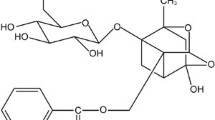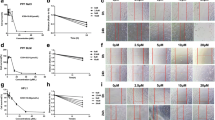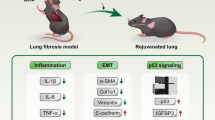Abstract
Background
Pulmonary fibrosis (PF) is a fatal inflammatory disease with limited effective strategies. Epithelial–mesenchymal transition (EMT) is a pivotal origin of myofibroblasts that secrete extracellular matrix (ECM) in the development of PF. High mobility group box 1 (HMGB1), one of the mediators of inflammation, has been proved abnormal activation in the pathogenesis of PF.
Aim
The present study was aimed to investigate the potential effects of total glycoside of Yupingfeng (YPF-G), the natural compound extracted from Yupingfeng san, on HMGB1 activation and EMT in bleomycin-induced PF, which was a serious disease of respiratory system.
Methods
The Sprague–Dawley (SD) rat model of PF was duplicated by intratracheal instillation of bleomycin (5 mg kg−1). After that, YPF-G (5, 10 mg kg−1) and prednisone (5 mg kg−1) were separately administered intragastrically, and then the rats were killed at days 14 and 28, respectively. Hematoxylin and eosin and Masson’s trichrome staining were performed to assess the histopathologic level of lung tissues, western blotting and the common kits were utilized to investigate the hallmarks molecule expression of ECM and EMT, and the level of HMGB1 in lung tissues and serum.
Results
We found that both dose of YPF-G markedly reduced bleomycin-induced alveolitis and PF in rats. Besides, the levels of HMGB1, laminin, hyaluronic acid, and hydroxyproline were effectively reduced. Meanwhile, the increased protein expression of HMGB1 and the mesenchymal markers including vimentin and alpha-smooth muscle actin, and the decreased protein expression of epithelial marker E-cadherin were dramatically inhibited after YPF-G treatment.
Conclusion
Our results demonstrated that YPF-G could ameliorate bleomycin-induced PF by reducing HMGB1 activation and reversing EMT.



Similar content being viewed by others
Abbreviations
- α-SMA:
-
Alpha-smooth muscle actin
- E-cad:
-
E-cadherin
- ECM:
-
Extracellular matrix
- EMT:
-
Epithelial–mesenchymal transition
- HA:
-
Hyaluronic acid
- HMGB1:
-
High mobility group box 1
- HYP:
-
Hydroxyproline
- LN:
-
Laminin
- PF:
-
Pulmonary fibrosis
- Vim:
-
Vimentin
- YPF-G:
-
Total glycosides of Yupingfeng
References
Borensztajn K, Crestani B, Kolb M. Idiopathic pulmonary fibrosis: from epithelial injury to biomarkers—insights from the bench side. Respiration. 2013;86:441–52.
Wynn TA, Ramalingam TR. Mechanisms of fibrosis: therapeutic translation for fibrotic disease. Nat Med. 2012;18:1028–40.
Pankov R, Yamada KM. Fibronectin at a glance. J Cell Sci. 2002;115:3861–3.
Chen YL, Zhang X, Bai J, Gai L, Ye XL, Zhang L, et al. Sorafenib ameliorates bleomycin-induced pulmonary fibrosis: potential roles in the inhibition of epithelial–mesenchymal transition and fibroblast activation. Cell Death Dis. 2013;4:e665.
Zhao H, Wu QQ, Cao LF, Qing HY, Zhang C, Chen YH, et al. Melatonin inhibits endoplasmic reticulum stress and epithelial–mesenchymal transition during bleomycin-induced pulmonary fibrosis in mice. PLoS One. 2014;9:e97266.
Mikaelian I, Malek M, Gadet R, Viallet J, Garcia A, Girard-Gagnepain A, et al. Genetic and pharmacologic inhibition of mTORC1 promotes EMT by a TGF-beta-independent mechanism. Cancer Res. 2013;73:6621–31.
Dass SD, Cheah PL, Ong DB, Teoh KH, Looi LM. E-cadherin downregulation at the infiltrating tumour front is associated with histological grade and stage in colorectal carcinoma of Malaysians. Malays J Pathol. 2015;37:19–24.
Hinz B, Celetta G, Tomasek JJ, Gabbiani G, Chaponnier C. Alpha-smooth muscle actin expression upregulates fibroblast contractile activity. Mol Biol Cell. 2001;12:2730–41.
Speca S, Giusti I, Rieder F, Latella G. Cellular and molecular mechanisms of intestinal fibrosis. World J Gastroenterol. 2012;18:3635–61.
Kalderen C, Stadler C, Forsgren M, Kvastad L, Johansson E, Sydow-Backman M. Svensson Gelius S. CCL2 mediates anti-fibrotic effects in human fibroblasts independently of CCR2. Int Immunopharmacol. 2014;20:66–73.
Xu L, Zheng N, He Q, Li R, Zhang K, Liang T. Puerarin, isolated from Pueraria lobata (Willd.), protects against hepatotoxicity via specific inhibition of the TGF-beta1/Smad signaling pathway, thereby leading to anti-fibrotic effect. Phytomedicine. 2013;20:1172–9.
Yoo H, Ku SK, Baek YD, Bae JS. Anti-inflammatory effects of rutin on HMGB1-induced inflammatory responses in vitro and in vivo. Inflamm Res. 2014;63:197–206.
Li LC, Li J, Gao J. Functions of galectin-3 and its role in fibrotic diseases. J Pharmacol Exp Ther. 2014;351:336–43.
Maeda T, Ozaki M, Kobayashi Y, Kiguchi N, Kishioka S. HMGB1 as a potential therapeutic target for neuropathic pain. J Pharmacol Sci. 2013;123:301–5.
Hamada N, Maeyama T, Kawaguchi T, Yoshimi M, Fukumoto J, Yamada M, et al. The role of high mobility group box1 in pulmonary fibrosis. Am J Respir Cell Mol Biol. 2008;39:440–7.
He M, Kubo H, Ishizawa K, Hegab AE, Yamamoto Y, Yamamoto H, et al. The role of the receptor for advanced glycation end-products in lung fibrosis. Am J Physiol Lung Cell Mol Physiol. 2007;293:1427–36.
Kao YH, Lin YC, Tsai MS, Sun CK, Yuan SS, Chang CY, et al. Involvement of the nuclear high mobility group B1 peptides released from injured hepatocytes in murine hepatic fibrogenesis. Biochim Biophys Acta. 2014;1842:1720–32.
Liu YL, Liu YJ, Liu Y, Li XS, Liu SH, Pan YG, et al. Hydroxysafflor yellow A ameliorates lipopolysaccharide-induced acute lung injury in mice via modulating toll-like receptor 4 signaling pathways. Int Immunopharmacol. 2014;23:649–57.
Lu GX, Bian DF, Ji Y, Guo JM, Wei ZF, Jiang SD, et al. Madecassoside ameliorates bleomycin-induced pulmonary fibrosis in mice by downregulating collagen deposition. Phytother Res. 2014;28:1224–31.
Liu Q, Lu L, Hua M, Xu Y, Xiong H, Hou W, et al. Jiawei-Yupingfeng-Tang, a Chinese herbal formula, inhibits respiratory viral infections in vitro and in vivo. J Ethnopharmacol. 2013;150:521–8.
Song J, Li J, Zheng SR, Jin Y, Huang Y. Anti-inflammatory and immunoregulatory effects of Yupingfeng powder on chronic bronchitis rats. Chin J Integr Med. 2013;19:353–9.
Gao J, Li J, Shao X, Jin Y, Lu XW, Ge JF, et al. Antiinflammatory and immunoregulatory effects of total glucosides of Yupingfeng powder. Chin Med J (English). 2009;122:1636–41.
Li L, Li D, Xu L, Zhao P, Deng Z, Mo X, et al. Total extract of Yupingfeng attenuates bleomycin induced pulmonary fibrosis in rats. Phytomedicine. 2015;22:111–9.
Gupta N, Su X, Popov B, Lee JW, Serikov V, Matthay MA. Intrapulmonary delivery of bone marrow-derived mesenchymal stem cells improves survival and attenuates endotoxin-induced acute lung injury in mice. J Immunol. 2007;179:1855–63.
Broekelmann TJ, Limper AH, Colby TV, McDonald JA. Transforming growth factor beta 1 is present at sites of extracellular matrix gene expression in human pulmonary fibrosis. Proc Natl Acad Sci USA. 1991;88:6642–6.
Chan AL, Rafii R, Louie S, Albertson TE. Therapeutic update in idiopathic pulmonary fibrosis. Clin Rev Allergy Immunol. 2013;44:65–74.
Gao J, Huang Y, Li P, Xu D, Li J, Liu Y, et al. Antifibrosis effects of total glucosides of Danggui-Buxue-Tang in a rat model of bleomycin-induced pulmonary fibrosis. J Ethnopharmacol. 2011;136:21–6.
Wu G, Du L, Zhao L, Shang R, Liu D, Jing Q, et al. The total alkaloids of Aconitum tanguticum protect against lipopolysaccharide-induced acute lung injury in rats. J Ethnopharmacol. 2014;155:1483–91.
King TE Jr, Pardo A, Selman M. Idiopathic pulmonary fibrosis. Lancet. 2011;378:1949–61.
Sha Y, Zmijewski J, Xu Z, Abraham E. HMGB1 develops enhanced proinflammatory activity by binding to cytokines. J Immunol. 2008;180:2531–7.
Li DL, Xu L, Gao J, Li LC, Zhao P, Zhang GQ, et al. Establishment of fingerprint of total glucosides of Yupingfeng by HPLC method. Chin Hosp Pharma J. 2015;35:21–5 (in Chinese).
Zhang L, Li Z, He W, Xu L, Wang J, Shi J, et al. Effects of astragaloside IV against the TGF-β1-induced epithelial-to-mesenchymal transition in peritoneal mesothelial cells by promoting smad 7 expression. Cell Physiol Biochem. 2015;37:43–54.
Acknowledgments
This work was finally supported by the National Natural Science Foundation of China (No. 81274172, No. 81473267, and No. 30801535), the Open Project Program of State Key Laboratory of Natural Medicines, China Pharmaceutical University (No. SKLNMKF201206), and Traditional Chinese medicine research project of the health department of Anhui Province (No. 2012zy53).
Author information
Authors and Affiliations
Corresponding author
Ethics declarations
Conflict of interest
All authors approved the final submission and declare that no potential competing interests exist.
Additional information
Responsible Editor: John Di Battista.
Rights and permissions
About this article
Cite this article
Cui, W., Li, L., Li, D. et al. Total glycosides of Yupingfeng protects against bleomycin-induced pulmonary fibrosis in rats associated with reduced high mobility group box 1 activation and epithelial–mesenchymal transition. Inflamm. Res. 64, 953–961 (2015). https://doi.org/10.1007/s00011-015-0878-x
Received:
Revised:
Accepted:
Published:
Issue Date:
DOI: https://doi.org/10.1007/s00011-015-0878-x




